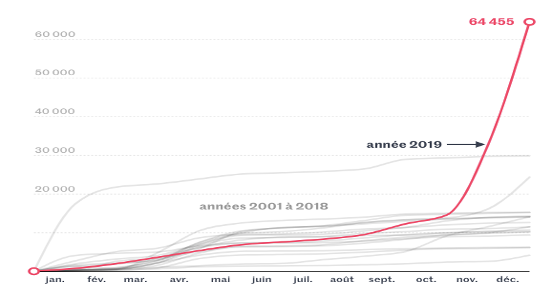Environment and volunteering
Page updated: 29 December 2020
The second exponential change described in the ‘key drivers’ section is climate change. Climate change, like technology, is changing our world exponentially in some respects.
Unfortunately, our brains are wired to think linearly, not exponentially. This makes it very difficult for us to accurately predict the potential future impacts of climate change, including on volunteering.
Climate change is exponential, not linear
We tend to think about change in terms of reasonably straight lines; where the future is a simple projection of the current trend. By contrast, we can demonstrate climate change is starting to have an exponential impact with a simple example.
The rapid and unprecedented increase in the number of bushfires in New South Wales alone is clearly visible in the graph below. As the graph shows, while for many years, hardly any change was detectable, in 2019, it suddenly represented five times the number of fires that happen in an ‘ordinary’ year!
Of course what this really demonstrates is that the very concept of an ‘ordinary’ year is beginning to break down – a classic symptom of exponential change.

Exponential increase in fires in New South Wales, 2001-2019
Rare disasters may become more common
How do you plan, recruit and train a largely volunteer-based workforce for search and rescue when you may have to face 5 times as many disasters as occurred in the previous year?
This is an important question for the SAR sector to face since we can consider Australia to be something of a ‘canary in the mine’ when it comes to the likely future impacts of climate change.
While New Zealand is not facing exponential change in demand for search and rescue right now, we can expect this to change in the future. Already New Zealand’s firefighters are being called on to assist with the so-called ‘mega-blazes’ in Australia, placing pressure on the remaining firefighters who may need to deal with fires back in New Zealand.
Similarly, major floods are likely to become much more frequent. GNS climate scientist Tim Naish, head of a new Government-funded programme set up to assess the magnitude and rate of sea-level rise says:
“We’re talking places we will not be able to live in because a so-called one-in-100-year flooding event becomes a daily event.” (Blundell 2018)
More fires, floods and other climate-related disasters could well lead to increased demand for rescue from people caught up in such events while participating outdoors, or at least more requests for support from civil defence agencies.
But what does all this mean for SAR volunteers?
Climate change may drive professionalisation of the SAR workforce
Arguably the current volunteer-dominated model of SAR service provision is based on a couple of thousand people getting ‘caught out’ annually. The viability of this model may well come under threat if climate change fulfils its exponential and disruptive promise.
The NZ government has reviewed its emergency management system and identified that a range of risks had arisen “in the face of the increasing number of events New Zealand is experiencing, and if a major emergency were to occur” (Department of the Prime Minister and Cabinet 2018)
Along with working towards a National Emergency Management Agency, the government agreed to focus on building a more professional, well-trained and accredited emergency management workforce (Civil Defence 2019).
The shift from a largely informal, volunteer-based workforce to a more professionalised one makes sense if we consider that there is a higher risk of large-scale and longer-lasting disasters in future.
While demand is currently reasonably static, in the future it appears likely that climate change will lead to more, and more frequent extreme events and disasters. It also appears likely that the current trend in volunteers preferring short term and episodic volunteering will continue.
Considering these two things together, it might be useful for the SAR sector to follow the example of the emergency management system and consider whether the current high reliance on volunteers (and a highly fragmented set of governance arrangements) will remain viable in the medium to long term.
